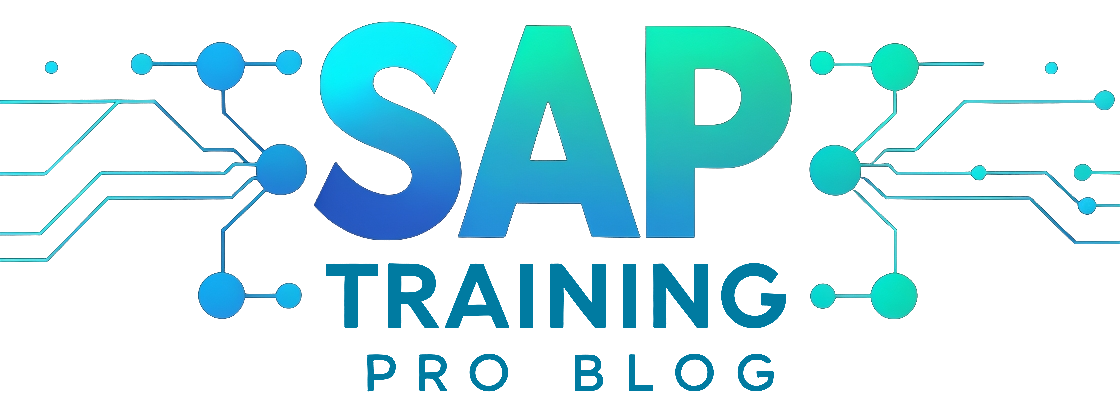Achieving ROI: Maximizing the Benefits of SAP Implementation

Achieving ROI: Maximizing the Benefits of SAP Implementation
Table Of Content
This article discusses strategies to achieve return on investment (ROI) and maximize the benefits of implementing SAP in an organization.
Implementing SAP in an organization can be a significant investment. Therefore, it is essential to have a clear understanding of how to achieve a return on investment and maximize the benefits of this implementation. This article explores various strategies that can help organizations achieve these goals.
One key strategy is setting clear objectives. By defining specific, measurable, achievable, relevant, and time-bound (SMART) objectives, organizations can align their SAP implementation efforts with their overall business goals. This ensures that the implementation is focused and targeted, leading to a higher likelihood of success.
Effective change management is another crucial aspect. Organizations must communicate the changes effectively, provide comprehensive training to employees, and engage stakeholders throughout the process. This helps in smooth transition and user adoption, minimizing resistance and maximizing the benefits of SAP implementation.
Aligning business processes with SAP functionalities is also essential. By mapping and standardizing processes, organizations can optimize their operations, enhance efficiency, and fully leverage the capabilities of SAP. Integration with existing systems is another critical aspect that ensures data consistency and eliminates duplicate efforts.
Data migration and cleansing are crucial for a successful SAP implementation. Organizations must follow best practices for data validation, cleansing, and transformation to ensure the accuracy and integrity of data. This lays a strong foundation for effective utilization of SAP functionalities.
Furthermore, user training and ongoing support are vital for maximizing the benefits of SAP implementation. Comprehensive training programs and continuous user support enhance user proficiency and satisfaction, leading to better utilization of SAP and higher ROI.
Finally, monitoring the performance of SAP implementation and continuously improving processes is key to achieving ROI. By measuring key performance indicators (KPIs) and implementing feedback loops, organizations can identify areas for improvement and make necessary adjustments to optimize their SAP implementation.
In conclusion, implementing SAP can be a transformative step for organizations. By following these strategies and focusing on achieving ROI, organizations can maximize the benefits of SAP implementation and drive their business forward.
Setting Clear Objectives
Defining clear objectives is crucial for a successful SAP implementation. When embarking on an SAP implementation journey, organizations must ensure that their objectives are specific, measurable, achievable, relevant, and time-bound (SMART).
Specific objectives provide clarity and direction to the implementation process. They outline the desired outcomes and help stakeholders understand the purpose of the SAP implementation. Measurable objectives enable organizations to track progress and evaluate the success of the implementation. By setting measurable targets, organizations can assess the effectiveness of their efforts and make necessary adjustments.
Achievability is another key aspect of setting clear objectives. Objectives should be realistic and attainable within the given resources and time frame. Unrealistic objectives can lead to frustration and hinder the implementation process. Relevant objectives align with the organization’s overall goals and strategic vision. They should directly contribute to the success and growth of the organization.
Lastly, objectives must be time-bound, meaning they should have a specific timeline or deadline. Time-bound objectives create a sense of urgency and help organizations stay on track. They provide a clear timeframe for achieving the desired outcomes and ensure that the implementation process progresses efficiently.
By setting clear objectives using the SMART framework, organizations can maximize the benefits of SAP implementation. These objectives serve as a roadmap, guiding the implementation process and enabling organizations to achieve a higher return on investment (ROI).
Effective Change Management
Change management is a crucial aspect of SAP implementation, as it sets the foundation for a successful transition and user adoption. Effective communication, training, and stakeholder engagement are key components of change management that ensure a smooth and seamless integration of SAP into an organization.
First and foremost, effective communication is essential during the implementation process. Clear and transparent communication helps to manage expectations, address concerns, and build trust among employees. It is important to keep all stakeholders informed about the purpose, benefits, and progress of the SAP implementation.
Training is another critical element of change management. Providing comprehensive training programs to employees helps them understand the new system, its functionalities, and how it aligns with their roles and responsibilities. Training should be tailored to different user groups and should include hands-on exercises and real-life scenarios to enhance user proficiency.
Engaging stakeholders throughout the implementation process is also crucial. Involving key individuals from different departments and levels of the organization fosters a sense of ownership and commitment. Their input and feedback can help identify potential challenges and ensure that the SAP solution meets the needs of the organization.
In conclusion, effective change management, encompassing communication, training, and stakeholder engagement, is vital for a successful SAP implementation. By ensuring a smooth transition and user adoption, organizations can maximize the benefits of implementing SAP and achieve a significant return on investment.
Aligning Business Processes
Aligning business processes with SAP functionalities is essential for maximizing the benefits. When implementing SAP, organizations must ensure that their existing processes are mapped and aligned with the capabilities of the SAP system. This involves analyzing and understanding the current workflows and identifying areas where improvements can be made.
Process mapping is a crucial step in aligning business processes with SAP. It allows organizations to visualize their current processes and identify any inefficiencies or bottlenecks. By mapping out the entire process flow, organizations can identify areas for standardization and optimization.
Standardization involves creating a uniform set of processes and procedures across the organization. This ensures consistency and reduces the risk of errors or inconsistencies. By standardizing processes, organizations can streamline operations and improve efficiency.
Optimization is another key aspect of aligning business processes with SAP. It involves identifying areas where processes can be improved or streamlined to achieve better results. This may involve eliminating unnecessary steps, automating manual tasks, or reorganizing workflows.
By aligning business processes with SAP functionalities through process mapping, standardization, and optimization, organizations can streamline operations, enhance efficiency, and maximize the benefits of SAP implementation.
Integration with Existing Systems
Integrating SAP with existing systems is a critical aspect of implementation. It presents both challenges and benefits that organizations need to consider for a successful integration. One of the main challenges is ensuring seamless integration to maintain data consistency across different systems. This requires careful planning and coordination to avoid duplicate efforts and data discrepancies.
On the other hand, the benefits of integrating SAP with existing systems are numerous. It allows organizations to leverage their current infrastructure and software investments while gaining the advantages of SAP’s powerful functionalities. By integrating SAP with existing systems, businesses can streamline their operations, improve efficiency, and enhance decision-making processes.
Data Migration and Cleansing
Data migration and cleansing are essential steps in ensuring a successful SAP implementation. In this subsubsubheading, we will explore the best practices for data migration, including data validation, cleansing, and transformation.
When migrating data to SAP, it is crucial to validate the accuracy and completeness of the data. This can be achieved through data validation techniques such as data profiling and data quality checks. By identifying and resolving any inconsistencies or errors in the data early on, organizations can prevent issues and ensure a smooth transition.
Furthermore, data cleansing plays a vital role in maintaining data integrity within the SAP system. This involves removing duplicate records, correcting inaccuracies, and standardizing data formats. By cleansing the data before migration, organizations can avoid data duplication, improve data quality, and enhance overall system performance.
In addition to validation and cleansing, data transformation is another critical aspect of data migration. This process involves mapping and converting data from the existing systems to the required format in SAP. It ensures that the data is correctly interpreted and utilized within the SAP environment, enabling seamless integration and efficient operations.
By following these best practices for data migration and cleansing, organizations can minimize risks, improve data accuracy, and maximize the benefits of their SAP implementation.
User Training and Support
User training and ongoing support are essential components of a successful SAP implementation. Comprehensive training programs play a crucial role in enabling users to effectively utilize the SAP system and maximize its benefits. By providing users with the necessary knowledge and skills, organizations can ensure a smooth transition and enhance user proficiency.
In addition to training, continuous user support is vital for maintaining user satisfaction and addressing any issues or challenges that may arise during the implementation process. This support can come in the form of help desks, user forums, or dedicated support teams. By offering ongoing assistance, organizations can ensure that users feel supported and confident in their ability to utilize SAP to its fullest potential.
To further enhance user proficiency and satisfaction, organizations can also consider implementing feedback loops. These feedback loops allow users to provide input and suggestions for improving the SAP system, ensuring that it continues to meet their needs and expectations over time. By actively seeking user feedback and implementing necessary improvements, organizations can create a user-centric SAP environment that maximizes the benefits of implementation.
Monitoring and Continuous Improvement
Monitoring the performance of SAP implementation and continuously improving processes is key to achieving ROI. By closely monitoring the system’s performance, organizations can identify any bottlenecks or areas for improvement, ensuring that the investment in SAP delivers the expected benefits.
To effectively monitor the implementation, organizations should establish key performance indicators (KPIs) that align with their objectives. These KPIs can include metrics such as system uptime, response time, user adoption rates, and cost savings. Regularly tracking these KPIs allows organizations to measure the success of the implementation and identify any areas that require attention.
Furthermore, implementing feedback loops is crucial for continuous improvement. By gathering feedback from users and stakeholders, organizations can identify pain points, address any issues, and make necessary adjustments. This feedback can be collected through surveys, user forums, or regular meetings with key stakeholders.
In addition, organizations can leverage data analytics tools to gain insights into the system’s performance and identify opportunities for optimization. These tools can provide valuable information on system usage, user behavior, and process efficiency, enabling organizations to make data-driven decisions for continuous improvement.
Overall, monitoring the performance of SAP implementation and continuously seeking ways to improve processes are essential for maximizing the benefits and achieving ROI. By measuring KPIs, implementing feedback loops, and leveraging data analytics, organizations can ensure that their SAP implementation remains efficient, effective, and aligned with their business objectives.


